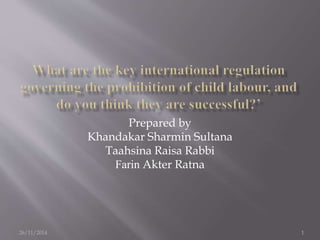
p.p.t. on child labour
- 1. Prepared by Khandakar Sharmin Sultana Taahsina Raisa Rabbi Farin Akter Ratna 26/11/2014 1
- 2. The term child labor is used for employment of children below a certain age, which is considered illegal by law and custom. The stipulated age varies from country to country and government to government. Child labor is a world phenomenon which is considered exploitative and inhuman by many international organizations. 26/11/2014 2
- 3. Exploitation of working children in developing countries has been reported since the 1800s. However, political awareness of the effects of working on children’s physical and psychological well being has gained substantial momentum in the international community only since the start of the 1990s. The International Labour Organization’s International Programme on the Elimination of Child Labour (IPEC), founded in1992, aims to eliminate child labour. It operates in 88 countries and is the largest program of its kind in the world. IPEC works with international and government agencies, NGOs, the media, and children and their families to end child labour and provide children with education and assistance. 26/11/2014 3
- 4. A general benchmark of child labour would include all children that are engaged in work that could be harmful to them . UNICEF defines child labour as work that exceeds a minimum number of hours, depending on the age of a child and on the type of work. such work is considered harmful to the child and should therefore be eliminated. The ILO Convention No 182 defines the worst forms of child labour as slavery and forced labour, commercial sexual exploitation, illicit activities and hazardous work. 26/11/2014 4
- 5. According to UNICEF, there are an estimated 158 million children aged 5 to 14 in child labour worldwide. Millions of children are engaged in hazardous situations or conditions. 26/11/2014 5
- 6. The main factor ‘pushing’ children to work is poverty. This is often compounded by a lack of access to, or poor quality, education, the effects of HIV/AIDS and discrimination based on gender or social grouping. In addition, the demand for child workers is high because they are usually cheaper, less demanding and more easily intimidated. 26/11/2014 6
- 7. Children are protected by various regulations, such as those that forbid or limit their employment if they are under a specific age, in particular occupations. International Covenants, adopted by the UN in 1966 contains a provision on child labour in Article 10 which states, Children and young persons should be protected from economic and social exploitation. Their employment in work harmful to their morals or health or dangerous to life or likely to hamper their normal development should be punishable by law. States should also set age limits below which they paid employment of child labour should be prohibited and punishable by law. The Convention states that every human being below the age of 18years is a child “unless under the law applicable to the child, majority is attained earlier” (Article 1). 26/11/2014 7
- 8. In 1973 Convention 138 stipulates that the minimum age for employment should “not be less than 15 years” but contains a number of special provisions, which allow developing countries to opt for a minimum age of 14 on what is supposed to be a temporary basis. In Article 3 for the purposes of this Convention, the term "the worst forms of child labour" comprises: (a) all forms of slavery or practices similar to slavery, such as the sale and trafficking of children, debt bondage and serfdom and forced or compulsory labour, including forced or compulsory recruitment of children for use in armed conflict; (d) work which, by its nature or the circumstances in which it is carried out, is likely to harm the health, safety or morals of children. In Article 7(2) taking into account the importance of education in eliminating child labour, take effective and time-bound measures. The Recommendation 190 for the Elimination of the worst forms of Child Labour calls on governments to identify and quantify the incidence of such child labour, backed by national plans for its elimination. The ILO aims to achieve this goal by 2016, backed by its ten-year Global Action Plan drawn up in 2006. 26/11/2014 8
- 9. In India: Government implemented a successful programme , the National Child Labour Project (NCLP) since 1988 where in 7,328 special schools were opened for the children withdrawn from work . The National Child Labour Project scheme is implemented in 250 districts of 20 states of the country. Under the Scheme, children withdrawn from work are provided education, nutrition, vocational training, stipend and health care etc. and are finally mainstreamed to regular education system In Morocco Unicef and its partners are working to reduce the number of children working in the handicraft sector in Fez. In Senegal, a debt- cancellation agreement between the Italian and Senegalese governments signed strategies, in particular towards the elimination of child labour. 26/11/2014 9
- 10. At last we can say that the future of a community is in the well being of its children. It is urgently required by implementing the international regulation for prohibition of child labour to ensure that they are given opportunities for healthy normal and happy growth of child’s mental physical , educational and spiritual development. So if the governments of those countries where child labour is a curse take necessary step to implement the international regulation for prohibition of child labour properly then we can hope that this regulation play a successful part to demolish the child labour from the world and from the humanity. 26/11/2014 10
- 11. 26/11/2014 11